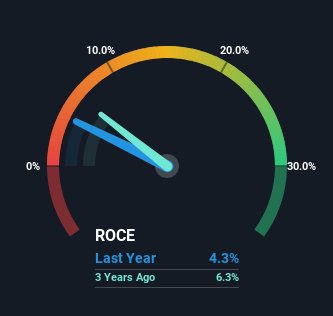- Taiwan
- /
- Semiconductors
- /
- TWSE:2338
The Returns On Capital At Taiwan Mask (TWSE:2338) Don't Inspire Confidence

Finding a business that has the potential to grow substantially is not easy, but it is possible if we look at a few key financial metrics. In a perfect world, we'd like to see a company investing more capital into its business and ideally the returns earned from that capital are also increasing. If you see this, it typically means it's a company with a great business model and plenty of profitable reinvestment opportunities. However, after briefly looking over the numbers, we don't think Taiwan Mask (TWSE:2338) has the makings of a multi-bagger going forward, but let's have a look at why that may be.
Return On Capital Employed (ROCE): What Is It?
For those who don't know, ROCE is a measure of a company's yearly pre-tax profit (its return), relative to the capital employed in the business. Analysts use this formula to calculate it for Taiwan Mask:
Return on Capital Employed = Earnings Before Interest and Tax (EBIT) ÷ (Total Assets - Current Liabilities)
0.043 = NT$542m ÷ (NT$22b - NT$9.9b) (Based on the trailing twelve months to March 2024).
Thus, Taiwan Mask has an ROCE of 4.3%. In absolute terms, that's a low return and it also under-performs the Semiconductor industry average of 8.2%.
View our latest analysis for Taiwan Mask

While the past is not representative of the future, it can be helpful to know how a company has performed historically, which is why we have this chart above. If you'd like to look at how Taiwan Mask has performed in the past in other metrics, you can view this free graph of Taiwan Mask's past earnings, revenue and cash flow.
The Trend Of ROCE
On the surface, the trend of ROCE at Taiwan Mask doesn't inspire confidence. To be more specific, ROCE has fallen from 7.1% over the last five years. On the other hand, the company has been employing more capital without a corresponding improvement in sales in the last year, which could suggest these investments are longer term plays. It's worth keeping an eye on the company's earnings from here on to see if these investments do end up contributing to the bottom line.
While on the subject, we noticed that the ratio of current liabilities to total assets has risen to 44%, which has impacted the ROCE. If current liabilities hadn't increased as much as they did, the ROCE could actually be even lower. What this means is that in reality, a rather large portion of the business is being funded by the likes of the company's suppliers or short-term creditors, which can bring some risks of its own.
What We Can Learn From Taiwan Mask's ROCE
Bringing it all together, while we're somewhat encouraged by Taiwan Mask's reinvestment in its own business, we're aware that returns are shrinking. Yet to long term shareholders the stock has gifted them an incredible 164% return in the last five years, so the market appears to be rosy about its future. However, unless these underlying trends turn more positive, we wouldn't get our hopes up too high.
Taiwan Mask does have some risks, we noticed 4 warning signs (and 1 which is potentially serious) we think you should know about.
While Taiwan Mask isn't earning the highest return, check out this free list of companies that are earning high returns on equity with solid balance sheets.
Valuation is complex, but we're here to simplify it.
Discover if Taiwan Mask might be undervalued or overvalued with our detailed analysis, featuring fair value estimates, potential risks, dividends, insider trades, and its financial condition.
Access Free AnalysisHave feedback on this article? Concerned about the content? Get in touch with us directly. Alternatively, email editorial-team (at) simplywallst.com.
This article by Simply Wall St is general in nature. We provide commentary based on historical data and analyst forecasts only using an unbiased methodology and our articles are not intended to be financial advice. It does not constitute a recommendation to buy or sell any stock, and does not take account of your objectives, or your financial situation. We aim to bring you long-term focused analysis driven by fundamental data. Note that our analysis may not factor in the latest price-sensitive company announcements or qualitative material. Simply Wall St has no position in any stocks mentioned.
About TWSE:2338
Taiwan Mask
Engages in the research, development, manufacturing, and sales of photomasks and integrated circuits for the semiconductor industry.
Second-rate dividend payer low.
Market Insights
Community Narratives



